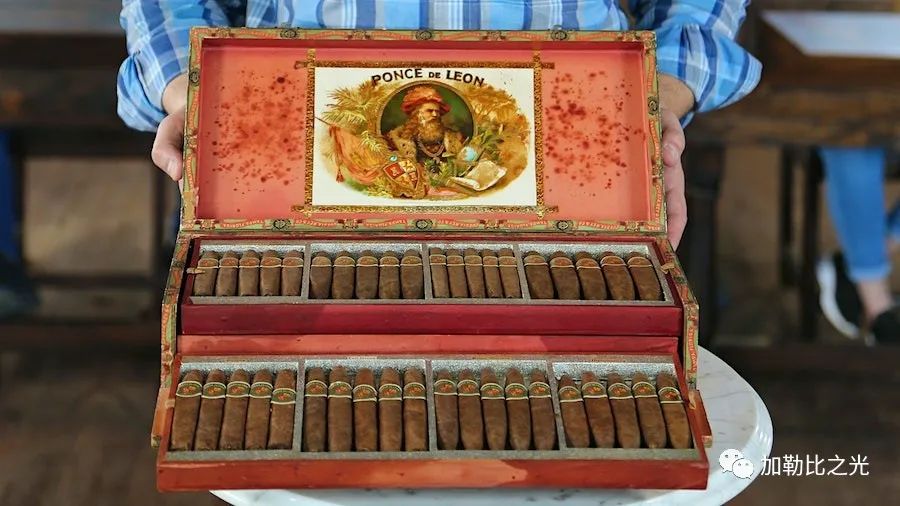
烟业智汇

零售户在线

微薰

手机版

位于坦帕市中心的时钟雪茄厂( El Reloj)从1910年开始就一直在生产雪茄,纽曼雪茄公司最近收购了一盒1906年出厂的奎斯塔·雷伊(Cuesta Rey)雪茄,这个文物比雪茄厂本身还要古老。如今这盒雪茄被放在了时钟雪茄厂的三楼的雪茄博物馆,在那里保管和展出。
虽然技术上这些雪茄还可以抽,但是过了116年,而且很长一段时间没有保管在雪茄保湿盒里,雪茄的烟草味道肯定大为减弱。纽曼家族认为,把这盒雪茄放在博物馆展览,发挥的价值要更大。
这盒雪茄设计成一个体验装的雪茄包装盒,装着奎斯塔·雷伊当时的一个产品线Ponce de Leon。这个产品线是在美国卷制的,使用的是古巴烟叶,在那个年代这样的做法很普遍。雪茄盒一共分为五个托盘,根据雪茄的形状和尺寸不同,又分为20个隔断,每个隔断装五支雪茄。
这种摆放样品的展示雪茄盒是当时位于坦帕市的奎斯塔·雷伊公司制作,该公司委托一些推销员到全国各地的零售商那里走访,介绍展示盒里的20款雪茄。
这盒幸存下来的雪茄起初存放在德克萨斯州的一个干燥黑暗的地下室,雪茄的主人是一名达拉斯的男子,但是不清楚他最初从哪里得到这盒雪茄,他将雪茄送给了朋友拉尔夫·斯托(Ralph Stow)。斯托本来打算将这盒雪茄送去参加一次慈善拍卖,但是他在研究这盒雪茄的起源后,找到了J.C. 纽曼雪茄公司。纽曼公司1958年买下了奎斯塔·雷伊的品牌所有权。
斯托得知纽曼公司经营着一家雪茄博物馆,他认为这是这盒雪茄最好的归宿地。他向纽曼公司提出物物交换,这样他可以继续完成慈善拍卖的愿望。纽曼公司提供了两件四英尺高的手工雪茄雕塑,和斯托交换了这盒古老的雪茄。斯托将这两件雕塑用于拍卖,而将收藏的奎斯塔·雷伊雪茄交给了纽曼公司。

在20世纪大部分时间里,奎斯塔·雷伊是坦帕市销量最大和最知名的雪茄品牌之一。19世纪末期,一名年轻的西班牙移民安吉尔·拉·马德里·奎斯塔(Angel La Madrid Cuesta )创办了一家雪茄厂,并很快获得了首屈一指的雪茄制造商的美誉。几年后,他和佩雷格里诺·雷伊(Peregrino Rey)合作建立了奎斯塔·雷伊品牌。他们的雪茄引起了上流社会的关注。尤其是西班牙国王阿方索十三世(Alfonso XIII),他授予奎斯塔“西班牙国王和宫廷烟草供应商”的称号。
J.C. 纽曼雪茄公司起初在克利夫兰营业,后来搬到了坦帕市。1958年他们收购了奎斯塔·雷伊品牌。有一段时间,纽曼公司将这个品牌变成了一个机制雪茄品牌,即使如此,仍然是药店和超市的畅销品。最后,公司的负责人斯坦福·纽曼(Stanford Newman)选择和老卡洛斯·富恩特( Carlos Fuente Sr.)合作,委托多米尼加的富恩特雪茄公司生产奎斯塔·雷伊品牌,变成手工卷制。合作关系一直延续到今天。
如果你要参观这盒历史悠久的雪茄,可以前往时钟雪茄厂。工作日的上午九点到下午五点半博物馆都会开放。包含导游费用的门票价格是每位成年人15美元,而老人、学生和退伍军人的票价是12美元。
JC. Newman’s historic El Reloj Factory, located in the heart of Tampa, has been producing cigars since 1910. But the combination cigar factory and museum has artifacts that are even older than the establishment itself—the company recently acquired a box of 100 perfectly pristine Cuesta-Rey cigars from 1906. The cigars were added to J.C. Newman’s three-floor museum where they will be preserved and displayed for future generations.
Though the cigars are technically still smokeable, after 116 years (many of them spent outside of a humidor) the tobacco’s flavor has surely diminished. The Newman family decided their value was much greater as an exhibit at their growing museum.
The box of cigars is a sampler’s case that features what was then Cuesta-Rey’s new line of Ponce de Leon smokes, which were hand-rolled in the United States with Cuban tobacco, as were many cigars from around the turn of the 20th Century. The display case carried 100 cigars in total, separated into five trays that were further denoted by sections of five based on the 20 different shapes and sizes the line of cigars came in. The display case was created by Tampa’s Cuesta-Rey Cigar Co., which commissioned a handful of traveling salesmen to visit retailers across the nation to introduce the new cigars. But how have the cigars fared so well after all this time?
J.C. Newman says a dark, dry basement in Texas played some part in the healthy survival of these smokes. A Dallas man kept them in his cellar for years, but it’s unclear for how long or where he got them from in the first place. Eventually, however, he decided to give them to a friend, Ralph Stow, who used the item in a charity auction to support Folds of Honor, a nonprofit organization that helps families of fallen and disabled service members obtain educational scholarships. Stow, who assists with the auction, soon decided that these smokes deserved a better fate than ending up in the hands of an individual.
Stow began researching Cuesta-Rey which led him to J.C. Newman, who has owned the brand since 1958. Seeing that J.C. Newman operated a cigar museum, Stow quickly understood this was the perfect home for the sampler’s box. With the auction still in mind, Stow proposed a trade, the cigars in exchange for promotional items to be auctioned off in their place. Newman offered up two four-foot-tall hand-painted sculptures of cigars and Stow accepted.
Cuesta-Rey was one of Tampa’s biggest and best-known cigar brands for much of the 20th century. Its history goes back to the late 19th century, when a young Spanish immigrant Angel LaMadrid Cuesta started a cigar factory and quickly garnered a reputation as a premier cigar roller. A few years later, he formed a partnership with Peregrino Rey and Cuesta-Rey was born. Their cigars earned them the respect of high society, particularly Spain’s King Alfonso XIII, who honored Cuesta with the title of “Tobacco Purveyor for the Spanish King and Court.”
J.C. Newman, originally operating in Cleveland, was also a 19th century conception, so it was only natural that a few years after the company moved to Tampa they would purchase the Cuesta-Rey brand, which happened in 1958. For a time, Newman transitioned Cuesta-Rey into a machine-made brand, but it was still a huge seller in drugstores and supermarkets. Eventually, Stanford Newman, longtime patriarch of the family business, would collaborate with another industry legend, Carlos Fuente Sr., to transfer the production of Cuesta-Rey to Tabacalera A. Fuente y Cia in the Dominican Republic, returning the brand to hand-rolled craftsmanship. The partnership between the families continues today and Cuesta-Rey remains a prominent brand for J.C. Newman after years of serving as its flagship cigar.
To see the historic box of cigars yourself, visit El Reloj in Tampa, open to the public on weekdays from 9:00 a.m. to 5:30 p.m. Guided factory tours are available for charge of $15 per adult and $12 per person for seniors, students and veterans.

笃行致远 2024中国烟草行业发展观察